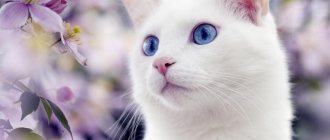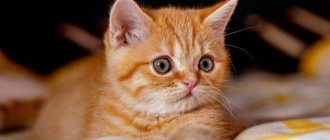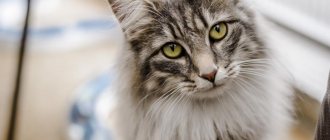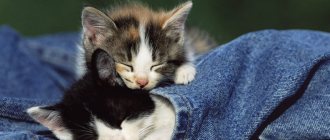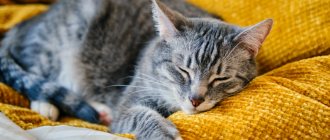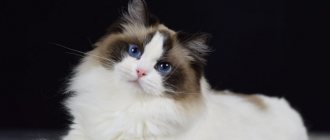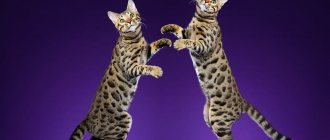Origin story
In the Irish Sea, exactly between the ports of Belfast and Liverpool, is the Isle of Man. It is famous not only for the megalithic complex “Castle on Heights”, but also for its tailless cats. Let us, however, make a clarification: not all Manx cats are completely devoid of such an important attribute. Some retain several vertebrae, and in some individuals the host has the length we are accustomed to.
The reason for this feature lies in a banal genetic anomaly - the isolation of the island and the lack of “new blood”, which ultimately led to connections between relatives. The result is a hole or a funny stump instead of a tail in the descendants.
The first exhibition was held in 1871 in England, and 30 years later a club for Manx cat lovers was organized there. The standard appeared a little later: in 1903.
Gradually, Manx cats began to spread throughout the globe: the first registration took place after the appearance of the breed in America. In Europe, Manx were not considered a separate species for a long time: precisely because of a genetic mutation, they were classified as a defective type and they insisted that breeding was simply dangerous for new generations. But the popularity of cats eventually broke even the most steadfast. Today, almost all major world felinological organizations have recognized them, and the CFA Association has classified them as Cymrics, considering them to be of the same type.
They are still arguing about their ancestors: they could have been British shorthair cats (they have many common features), but one thing is certain: the first cats were brought there by settlers, took root and began to actively reproduce.
Purchasing a Manx kitten
Manx are extraordinary and attractive animals, which contributes to their popularity throughout the world. Problems with breeding offspring make it difficult to acquire them even in Europe and America, despite the fact that there are nurseries for breeding Manx cats abroad. There are no registered nurseries in Russia. There can only be offers for sale from private owners. In any case, you must pre-book the purchase of a kitten.
The price of a small Manx largely depends on its class: whether it is a Rumpy, Rumpy Rysler, Stumpy or Longy, as not all classes are eligible for show. The price is also influenced by the pedigree of the parents and whether they have championship titles. When purchasing abroad, the cost of the kitten will include shipping costs.
Kittens with docked tails can be adopted into a new home after three months, as they are not prone to the characteristic diseases of the breed. In other cases, Manx cats are purchased at the age of four months or older to ensure the health of the animal.
The minimum price for a Manx kitten is four hundred and fifty dollars. If you are planning to buy a champion-level baby, be guided by the cost several times more.
When making a deal, carefully study the pedigree of the future pet, since the recessive tailless gene affects the health of the offspring and mating of a rampie with a rampie, which can lead to hidden genetic diseases, is not recommended. Remember that not all tailless cats are Manx. This breed has a characteristic build and a jumping gait.
Pay attention to the baby's appearance: he should look healthy (clean eyes, ears, anus, no scratches on the skin or bald spots) and active. Observe how he moves - whether there are any difficulties when walking and signs of dystrophy of the hind limbs.
The body type of these kittens corresponds to the Manx breed
When completing a transaction, you should receive a package of documents:
- contract of sale;
- kitten's passport indicating its name, date of birth and pedigree;
- certificate of primary vaccination.
Video: Manx is a breed of cats that does not have a tail (a Manx breeder talks about some of the features of the breed)
Standards
Manx weigh little: males weigh a maximum of 5 kg, females - 3.5-4 kg.
| Standard | Description |
| Head | Round, small, chubby cheeks. The ears are erect, with rounded tips. Both inside and outside are abundantly pubescent. The cheekbones are wide and prominently protruding. |
| Eyes | Larger, wide open, set slightly askew. The iris can be any color, but matching the color is highly valued. |
| Frame | Rectangular, elongated, massive, with strong bones. The hind legs are longer than the front legs, the front legs are short and strong, which is why the cat’s sacrum is noticeably raised. The chest is wide, the back is arched. Short and massive neck. The paws are round and elastic. |
| Wool | Thick and plush to the touch. There is a dense undercoat. The Manx's fur feels like a rabbit's skin. |
There are 4 types of tails:
- Rumpy: there are no tail vertebrae at all, and in the place where the tail is located in other cats there is a fossa. Such cats are rated higher than others at exhibition events.
- Rampy riser: there are 1, 2 or 3 vertebrae. They are allowed to participate in exhibition events, but only if the cat passes a kind of test: a specialist pets the animal and, if the vertical tail does not interfere with the hand, the cat is considered admitted.
- Stampi (stampi): from 5 to 14 fused vertebrae (lumpy or in tension).
- Longi: The tail of this species is of standard length. Many owners stop it in kittens: this helps prevent ossification of the vertebrae in old age.
Manxes, unfortunately, are a rare breed and it is difficult to find a cattery. And not only in our country, but also in neighboring countries. Most of them are concentrated in the United States, but there are a few in Europe. Therefore, acquiring a Manx is a difficult and expensive task. The approximate price tag is from $450 and above. The cost consists of several factors: it is not only the geographical location of the seller, but also the class, the merits of the parents, whether the animal is purchased for breeding or for oneself. To purchase a show-class Manx, you must make a reservation in advance.
Disqualifying signs:
- No slanted eyes;
- Triangular head;
- Excessively elongated torso.
Breeding
The Manx breed has several features associated with its breeding:
- Despite the rapid growth of kittens, puberty of Manx cats occurs only at three years of age.
- The offspring is heterogeneous: babies of any of the four possible subspecies may be present in the litter. Babies with a ponytail need to have it docked in the first five days. Otherwise, an adult Manx may experience ossification of the vertebrae, causing a very painful condition for the animal.
- The Manx taillessness gene is associated not only with skeletal abnormalities, which manifests itself in vertebral fusion, shortening of the back and a number of disorders of internal organs, but also with a lethal factor. Because of this, a large percentage of kittens die immediately after birth.
- It is absolutely futile to mate two Manx Rumpies with each other, because there will be very few surviving kittens. There is a greater chance of survival when mating with a stumpy. It is most advisable to breed a rampi with a longi, and best of all with a European shorthair cat.
- A Manx cat's litter should not contain more than four cubs. If her closest relatives had more babies, such a cat must be constantly examined at a veterinary clinic during pregnancy, since there is a high probability of death of the unborn kitten, and this can lead to the death of the mother.
If you are not afraid of these difficulties and you firmly want to start breeding the breed, you need to start looking for a mating partner in advance. It’s easier to do this through the breeder from whom you bought the kitten. If this is not possible, contact your regional felinological organization.
To carry out mating you need to consider:
- the cat is introduced to its partner on the third day of estrus;
- It is better to breed young individuals with more experienced ones, but this is not a necessary condition;
- animal communication takes place in the cat’s place of residence so that he feels more confident;
- the cat is transported in a carrier, then she must leave it and enter a new territory;
- the female stays as a guest for several days for a more confident result.
Manx cats are very good mothers, but they sometimes have few kittens.
Character and behavior
Reviews about these cats are the most positive. They are friendly and intelligent, and feel comfortable both in a large, noisy family and in a small one-person family. They love attention very much, but do not demand it, and are excellent at entertaining themselves. They are active, love to run and jump, so you should equip a special cat corner in which your pet can climb as much as he likes.
Manx treat people with great sympathy, both acquaintances and strangers. They are not afraid of guests and are the first to come up to introduce themselves, and at first they behave more than restrained, but when they get used to it, they allow themselves to be naughty, like kittens.
Children are not offended: we are ready to entertain them from morning until evening. They get along well in the same apartment with dogs (even large ones) and cats, but only if the neighbors behave calmly and do not show aggression. Manxes also know how to stand up for themselves.
They are obedient, quickly grasp information on the fly, and rarely allow themselves to be capricious about food or filler. They love to look at water flowing from a tap or shower. Some individuals even manage to open the taps for this!
They are excellent fishermen and hunters, so choose who will live in the same house with you: either Manx, or fish and decorative rats.
After running and jumping, they can rest for a long time, sitting on the windowsill and looking with interest at the world behind the glass. If you open windows for ventilation, install special strong nets on them in advance so that your pet does not fall out.
Expert opinion
Dusheba Vera Ivanovna
In 2010, she graduated from the Moscow State Academy of Veterinary Medicine named after K.I. Scriabin with honors, specializing in veterinary medicine. I regularly attend veterinary conferences, congresses, and webinars.
Do not allow your pet to climb onto high cabinets: the lack of a tail prevents them from grouping properly when doing so, and the cat can be seriously injured.
Since Manx cats have fur that grows very close to the anus (and there is no tail), the remains of excrement often stick to it. Therefore, you will have to look under the cat’s tail every day, and, if necessary, clean contaminated areas.
Description of the Manx breed
Manxes are unique in their appearance: their rounded outline and peculiar gait, uncharacteristic of cats, are more reminiscent of a rabbit. But it is precisely this gait that distinguishes this breed. Apart from the lack of a tail, Manx cats are very similar to British Shorthair cats, not only in appearance, but also in character.
One of the features of the Manx breed is the large difference in size between males and females. Cats have a medium-sized body, strong and robust. The cats look unusually small and graceful, sometimes not growing larger than a four-month-old European Shorthair kitten.
In Manx litters, not all kittens are tailless. Depending on the presence of this part of the body, the following subspecies of the breed are distinguished:
- rampi - complete absence of a tail;
- the rampy racer has a tuft of fur instead of a tail;
- Stumpy has a short tail, usually hooked or knotted;
- Longi has a medium-length tail.
Photo gallery: varieties of Manx
Manx Rumpy has absolutely no tail, instead there is a small indentation
The Manx Rumpy Racer has a tail consisting of several vertebrae, so it is practically not felt when stroking it
Manx Stumpy cats are always classified as domestic cats without access to exhibitions.
Manx Longi has a tail of almost normal length, but most often it is docked at an early age for medical reasons.
Rampi and partially Rampi-Rysler classes are allowed to participate in exhibitions.
The absence of a tail does not affect the Manx's ability to maintain balance, although they are not very willing to climb trees. But thanks to their powerful hind limbs, they can give cats of any other breeds a run for their money when running and jumping high.
Table: description of the Manx breed standard
| Standard requirements | |
| Head | The head is relatively large, rounded with a proportional, partly concave nose of medium length without a stop. The cheeks are plump, cheekbones prominent, the chin is well developed, the vibrissae pads are noticeably expressed by hair follicles. The neck is short and thick. |
| Eyes | The eyes are large, round and expressive, and should match the color of the coat, as should the nose and paw pads. White cats can have blue, orange, or different blue and orange eyes. The setting of the eyes has a slight slant. |
| Ears | The ears are medium to large, wide at the base, tapering to slightly pointed (English standard) or rounded (American standard) tips, slightly tilted forward and set fairly high on the head. |
| Body type | The standard typical skeletal mutation is expressed by a large croup, a highly developed rear part of the body with wide sides, powerful hips and limbs much longer than the front ones, which resulted in the jumping rabbit gait of the Manx. Their shortened back is curved in an arc between the shoulders and sacrum. The skeleton is strong, the chest is strong and wide. The loin is somewhat convex, but in the front part the sides are slightly sunken. The body is short, muscular, dense. The legs are slender, the paws are neat and rounded. |
| Color | The color can be any (in the USA, chocolate, lavender, Siamese variants and all combinations of these colors with white are excluded). But in general, the color of the Manx is not so important, the main thing is the correspondence of body parameters. |
| Wool | The wool has a special structure, short, with a thick undercoat, but soft and fluffy, like that of a rabbit. The double and shiny impression is given by the guard hair, which is not as fine and silky as the undercoat, moreover, it is longer and not too close-lying. Manx cats are a short-haired breed, although if there is a good pedigree, individuals with longer hair are also allowed to be exhibited. The long-haired Manx was identified as a separate breed several decades ago, giving it the name Cymric. |
| Weight | The weight of cats is about four kilograms, males - over five. |
Video: Manx cat
Character of Manx cats
These cats are good rodent hunters and often clever fishermen. Very mobile, hardy and unpretentious, they easily adapt to a wide variety of living conditions. They are distinguished by a calm, balanced character and friendly attitude towards people. These are loyal and gentle pets, inquisitive and smart, funny and understanding. They can be trained like a dog to carry things. They like to feel like they are members of the family, and when ignored by their owners and left to their own devices, they sometimes become offended. From their ancestors who traveled on pirate sailing ships on the Irish Sea, they retained the habit of watching the flowing water. And if you don’t have a small fountain at home, then Manx can organize his own entertainment by pressing the button on the flush tank.
If there are no mice in the house, then you can hunt for a toy
Manx can communicate well with children. They are friendly towards everyone around them and will not let out their claws in play. It is only advisable that children do not cause pain to the cat by pulling its ears, whiskers and the remains of the tail, because this is a very painful place for Manx cats.
Pets of this breed feel great in an apartment and do not need special walking, but if you have a private house, Manx will happily explore the entire surrounding area.
Video: favorite gaming spot
Care instructions
Human care products - shampoos, toothpastes, gels, etc. - are designed exclusively for humans and are not suitable for animals. The components included in their composition can cause not only banal skin dermatitis, which takes a long time and is difficult to treat, but also intestinal upset and even poisoning. Therefore, buy care products only in pet stores. You don’t have to grab the most expensive ones - and the cheap ones do their job perfectly.
Wool
Thick fur requires regular grooming. During the shedding period, the cat needs to be brushed daily, the rest of the time - 1-2 times a week. To do this, you will need a fine-toothed metal comb, a comb with natural bristles and a furminator. It is better not to untangle the resulting tangles (this causes severe discomfort to the animal), but to cut them off with nail scissors.
Does your cat like to swim?
Not really
Eyes
The eyes are washed daily by soaking a cotton pad in strong tea leaves, fresh chamomile infusion or clean boiled water.
Ears
The ears are examined every week. If dirt and wax have accumulated in them, wipe it off with a cotton pad soaked in ear lotion. You cannot pour anything inside, nor use aggressive products (with alcohol, dyes and fragrances).
Teeth
Brush your teeth 2-3 times a week using cat toothpaste and a baby toothbrush with trimmed bristles.
Peculiarities of breeding Manx cats
The first estrus in females occurs at 7–8 months, and males can demonstrate readiness for mating as early as 5 months. However, the first mating for males and females is recommended no earlier than 3 years - only by this age the body develops sufficiently and becomes stronger.
Some breeders note that Manx dogs have cases of late development, when the animal first demonstrates its readiness to mate only at 5 years of age.
If you do not intend to use your pet for breeding or do not have the right to do so under an agreement with the breeder, the animal must be castrated or sterilized. European standards (by which this breed is mainly bred) require surgery for females at 6 months, for males at 9 months.
Commercial breeding
Manx cats are quite difficult to breed.
The main difficulty is acquiring manufacturers. There are very few breeders in Russia and the CIS countries, so it is possible that purchasing an animal will require a long journey.
It must be remembered that tailless cats cannot be crossed with each other - the offspring will most likely die unborn, and if they are born, they will die from Manx syndrome. One of the producers must be a Stumpy or Long type. Breeding with other breeds is not allowed.
To produce healthy offspring, one of the parents must be long-tailed from birth.
Another danger is multiple pregnancy. Usually there are 3-4 kittens in a litter, but if there are more, one embryo may die, which will result in intoxication of the cat’s body and its death. Therefore, when purchasing a breeding female, it is important to clarify whether her mother, grandmothers or sisters have had multiple pregnancies.
If the ultrasound showed more than 4 embryos, monitoring the pregnant female should be especially close. It is advisable to undergo an examination by a veterinarian and an ultrasound scan several times during pregnancy. If necessary, an abortion is performed.
The search for a partner for mating is carried out through clubs and nurseries - again, most often foreign. Pet owners must demonstrate their pets' pedigrees and medical certificates. Both male and female cats must be vaccinated and treated for worms before mating.
Mating takes place on the cat's territory, optimally on the third day of estrus. Usually the cat is left there for several days - several matings are needed to guarantee conception.
Pregnancy lasts on average 63–65 days.
The responsibilities of the cat owner include the initial course of vaccination and paperwork for kittens.
Catering
How to feed the animal - the owner must decide in the first weeks of the kitten's appearance in the house, since jumping back and forth will not benefit the animal, and feeding it either natural food or ready-made food is completely harmful. Manx are not picky, and are easily accustomed to both the first and second options. If the breeder’s baby ate dry food, and you plan to prepare his food yourself, transfer the kitten to a new regime gradually.
When choosing a menu, remember a few rules:
- Adult animals are fed no more than 2 times a day (an exception is made for weakened animals, lactating and pregnant cats), kittens 4-6 months - 3-4 times a day, under 4 months - 5-6 times.
- Drinking water must be fresh. Change it 2 times a day. Tap water is not suitable: it may contain harmful compounds and components. Drinking water can be purified using a filter or settled. Cats should not be given tea, juices or herbal decoctions; the same applies to compotes, alcohol and alcohol-containing products.
Natural products
Natural feeding does not mean that the cat is suitable for food from your table. Most of the dishes are absolutely not suitable for animals. This applies to sweet, salty, sour, flour, fatty, spicy, smoked, canned. As you can see, the list is extensive.
In addition, Manx should not be given fatty meat (pork, goose, lamb), large bones and tripe, lard, river fish, raw eggs, dairy products with dyes, potatoes, tomatoes, fruits (except for apples and melons), flour, baking.
But lean meats, sea fish, porridge, stewed vegetables (zucchini, carrots, beets, pumpkin, asparagus, broccoli, green salad), raw chicken yolk, low-fat sour cream, yogurt and kefir can and should be given.
Be careful with cow's milk: some adult cats stop digesting lactose as they age. Porridge and meat are cooked in plain water, without salt and spices.
Recommended food
Holistic and super-premium food classes are made from much better quality products than premium and economy food classes. They cost more, of course, but the price tag is quite reasonable: they contain dehydrated meat, plenty of vegetables and berries, and only natural preservatives. Examples of high-quality food from the holistic group: Acana, PureLuxe, Wildcat; super-premium: Brit Care, Savarra, Vet Life. And be sure to pay attention to the markings: age, health status, activity level of the animal.
Below are recommended super-premium foods. Links with the names of the food are clickable, on them you can, within our website, get acquainted with the descriptions of the food and read reviews from owners of Manx cats.
| Holistic | Super premium | Super premium |
| Gather | Guabi Natural | Mealfeel |
In addition to food, you should choose the right vitamin and mineral supplement. Dry brewer's yeast can be purchased independently and given in courses, following the instructions. The rest should be purchased only after consultation with a veterinarian.
Sterilization of Manx
If, when purchasing a kitten, you did not set out to breed the breed, then it is advisable to sterilize your pet in a timely manner. This procedure will save you and your pet from many problems. A sterilized animal retains the behavior of a kitten longer (for Manx cats this period can last up to the age of five), and will be calmer, balanced and attached to the home. Apart from the fact that during heat, cats become aggressive and can scream loudly, calling for a partner, and after puberty, cats mark their territory and it is very difficult to fight this smell.
The best sterilization period for a cat is nine months. As for cats, they are recommended to be spayed before their first heat, but since Manx cats reach puberty late, it is best to consult a veterinarian about the timing of the operation.
The sterilization operation is carried out in any veterinary clinic. There are several types of sterilization of cats and female cats. Consulting with your veterinarian will help you determine what is safest for your pet. And although the operation is performed under general anesthesia, it is one of the simplest. The most difficult part is the rehabilitation of the animal after general anesthesia. You take your pet home and provide it with the necessary care for several days.
A healthy animal with good care quickly overcomes the consequences of surgery. However, to avoid possible complications, you should carefully monitor her awakening from anesthesia. To do this, you need to prepare a flat bed with a pillow, covered with a woolen blanket and covered with linen or cotton fabric. The room must be at an optimal temperature. The light must be dimmed so that when the cat wakes up, it does not blind her.
After waking up, the cat needs to be given water to drink. If she cannot drink on her own, you can use a syringe without a needle. It is recommended to feed the cat only on the third day after surgery with soft food: cottage cheese, grated with yolk, boiled fish, pureed meat, porridge, broth.
It is necessary to periodically inspect postoperative sutures. They should not have redness, swelling and be dry. They can be additionally disinfected with hydrogen peroxide. In case of any complications, immediately contact a veterinary clinic.
Diseases
- Corneal dystrophy - this pathology occurs only in the Manx breed and is characterized by gradual clouding of the cornea of both eyes, turning into an ulcer. At the same time, the cat loses its appetite, has lacrimation and nasal discharge. Diagnosed at the age of 3-4 months. Treatment can be either medication or surgery. During treatment, cats need complete rest and isolation from people and animals.
- Pyoderma of the posterior part of the body is an inflammation of the skin with the release of pus. Reason: a consequence of advanced allergic dermatitis or infection in the wound. The fur begins to fall out, and blisters with purulent contents appear on the skin. The cat begins to scratch and lick the injury site and sleeps poorly. Untimely treatment can cause the formation of colloidal scars, decreased immunity, and sepsis. It is recommended to carefully cut off all the hair in the affected area, treat the skin with iodine solution, potassium permanganate or chlorhexidine, and lubricate it with antibacterial ointment (Bacitracin, Mupirocin, Baneocin).
- Concrescence (fusion of vertebrae) is one of the most serious diseases. Medicines help improve the quality of life.
- Spina bifida (congenital) is characterized by the following symptoms: back pain, hunched back, refusal to climb stairs or jump on chairs and sofas. Treatment depends on the severity of symptoms. In some cases, it is enough to provide the animal with rest; in more severe cases, surgery is indicated.
- Manx syndrome: with this pathology, the structure of the spinal column and brain stem is disrupted, problems arise with defecation and urination, coordination, and gait. Often a hernia appears, pinched nerve endings in the spine and fusion of the vertebrae.
A pair of tailless genes leads to the fact that the offspring often die. Therefore, experts recommend breeding one tailless and one tailed Manx.
Expert opinion
Dusheba Vera Ivanovna
In 2010, she graduated from the Moscow State Academy of Veterinary Medicine named after K.I. Scriabin with honors, specializing in veterinary medicine. I regularly attend veterinary conferences, congresses, and webinars.
If you notice that your pet's behavior has changed (for example, he began to sleep constantly or sleep little, he itches, refuses to eat, has difficulty walking) - take the cat to the veterinarian for an examination. Timely assistance can not only restore health, but also save lives!
Do not try to diagnose and cure your pet on your own, buying medications at the pharmacy at your own discretion. Some illnesses have similar symptoms, and if you miss the time, the situation will get much worse. Don’t forget about preventive vaccinations and deworming: even if your cat is completely domestic and has only seen the street from the window. A number of dangerous pathogens can enter the house on human shoes, clothes and hands (if you do not wash your hands first, but pet the cat, you should know - this is a bad habit), with food or water.
What diseases are typical for Manx cats?
Like all domestic cats, Manx cats are susceptible to a number of feline diseases. To keep your pet healthy, you must follow the following preventive rules:
- adhere to a balanced diet;
- carry out the necessary revaccination on time;
- monitor the animal’s teeth and oral cavity;
- get rid of fleas and ticks in a timely manner;
- Carry out deworming at least twice a year, even if your pet does not leave the apartment.
But besides this, Manx cats are prone to diseases associated with the characteristics of their breed. No tail means a shorter spine; Pathologies caused by this body structure can manifest themselves in the form of the following diseases:
- Manx syndrome: The kitten's spine grows too slowly compared to its body. Usually such kittens live no longer than four months.
- Congenital spina bifida, which leads to various neurological disorders of the cat’s body.
- Dystrophy of the hip joint, which is a pathology of the hind limbs of the animal.
- Various bladder and bowel dysfunctions.
- Corneal dystrophy. This disease is genetic. As a treatment, it is recommended to remove the dystrophy zone. If the disease is detected, such animals are not allowed to breed, but it does not affect the general health.
Most congenital diseases are detected in the early stages and such kittens are discarded. Adult animals have good immunity to colds and get sick infrequently. The average lifespan of a Manx is fourteen years.
Even a completely healthy cat needs a preventive examination by a veterinarian.
Animals are disqualified from participating in exhibitions in the following cases:
- poor physical condition, including runny nose and sneezing;
- weak hind limbs;
- when examining the profile, a stop or bend in the nose is evident;
- not slanted eyes;
- lack of toes (oligodactyly), fusion of toes (syndactyly) or excess (polydactyly);
- the presence of external parasites (the absence of internal ones is documented).
Only Rumpy and Rumpy Rysler take part in the exhibitions (provided that if you run your hand along the spine of such an animal, you will not feel the tail).
History of the Isle of Man Cats
The history of the origin of cats is very long.
The name "Manx" comes from the Isle of Man, which is located in the sea of Ireland. It is generally accepted that the cat originates from there.
There is also an opposite opinion; it is believed that the cat is a native of the Far East.
According to historical data, the cat was found on mainland China and its islands, Malaysia and even in Russia.
And it was brought to Europe by sea around 1588, perhaps it was just the Spanish sailors who were returning home after the defeat of the armada of Philip II.
Table: pros and cons of the breed
| Advantages | Flaws |
| Friendliness, loyalty to the owners | Low prevalence and high cost |
| Good attitude towards children | The danger of genetic diseases |
| Intelligence and acumen | Difficulties in breeding, risk of death of the female |
| Easy adaptation to new conditions | Possibly obsessive behavior and dependence on human attention |
